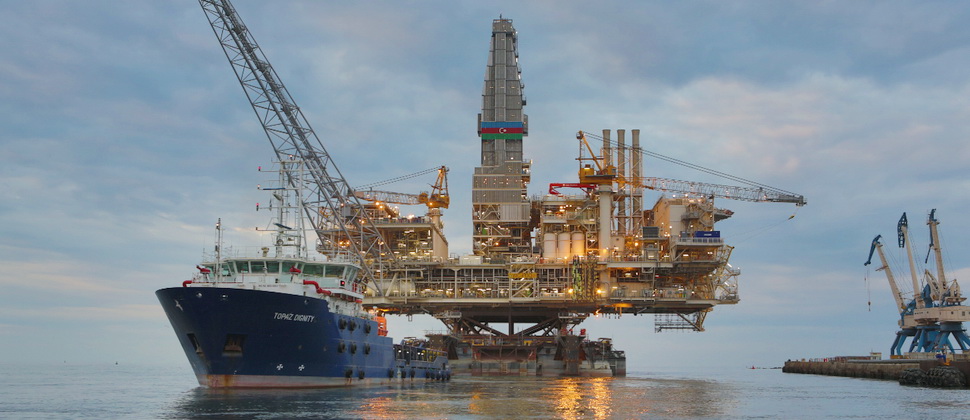The Shah Deniz 2 natural gas field, forming part of Azerbaijan’s reserves off its Caspian Sea coastline, will begin pumping gas and feeding into the Southern Gas Corridor mega-pipeline to Europe, starting this week.
“The gas is already in the system, and the most recent checkout work is currently in progress,” the Vice President of BP-Azerbaijan, Bakhtiyar Aslanbeyli, told Trend on Thursday.
“As soon as there is an order from the recipient, which we expect at the beginning of next week, gas will be delivered,” he said, referring to the Turkish pipeline company Botaş.
Shah Deniz is Azerbaijan’s largest and one of the world’s richest gas condensate fields. Located in the deep water shelf of the Caspian Sea, 70 km (44 mi) southeast of Baku and at depths ranging from 50 to 500 meters (55 to 547 yards), the field will be the sole provider of gas to the Southern Gas Corridor, which is comprised of three separate but connected pipelines that traverse six countries and feed into energy grids of Europe and Turkey.
BP is the largest shareholder of Shah Deniz and the operator of the field, considered its largest discovery after the Prudhoe Bay oil field in Alaska. About 1.2 trillion cubic meters (42.38 trillion cubic feet) of natural gas and 2.2 billion barrels of condensate are trapped within the underwater deposit. BP controls 28.8 percent stake in the field, with TPAO taking 19 percent, SOCAR 16.7 percent, Petronas 15.5 percent and other companies comprising the remaining 20 percent.
Shah Deniz was developed in two phases, dubbed Shah Deniz 1 and Shah Deniz 2. The consortium began developing Shah Deniz 1 in 2006, which currently churns out 10 billion cubic meters of gas per year and approximately 50,000 barrels of condensate per day. Azerbaijan’s neighbors Georgia and Turkey are the main buyers of natural gas extracted from Shah Deniz 1, delivered via the Baku-Tbilisi-Erzurum pipeline.
Shah Deniz 2 went into operation in 2014, after an agreement was inked two years earlier between Turkey and Azerbaijan to build the Southern Gas Corridor. Currently Shah Deniz 2 is the sole supplier to the corridor and will provide Turkey and continental Europe with 16 billion cubic meters of natural gas per year. Six billion will go to Turkey, and the remaining 10 to Europe. While supplies to Turkey began this year, gas pumped further westward to Europe will not happen until 2020.
The 3,500 kilometer-long (2,175 mile) corridor consists of three pipelines: the South Caucasus Pipeline, the Trans-Anatolian Pipeline (TANAP) and the Trans Adriatic Pipeline. The South Caucasus line runs from Azerbaijan, through Georgia, and into far eastern Turkey, where it connects to TANAP. That pipeline runs the entire length of the country from east to west, before connecting to the Trans-Adriatic Pipeline (TAP), which traverses Greece and Albania before dipping beneath the Adriatic Sea and connecting to Europe’s power grid via southern Italy.
The South Caucasus Pipeline Expansion project was completed this year. TANAP, the largest segment to the corridor, went online on June 12. As of February two-thirds of TAP had been completed and will be ready to receive deliveries of Caspian gas beginning in 2020. The corridor is expected to help Europe stabilize its energy dependence on other countries and diversify its imported sources.
Frank Fannon, the U.S. Assistant Secretary of State for Energy Resources, said in a speech at the World Gas Conference held in Washington D.C. on June 28, that the corridor is supported by the Trump administration and is a key to enhancing European energy security.







 The number of evacuees from flooded areas in Kazakhstan has reached 97,852 people, including about 32,856 children since March 27.
The number of evacuees from flooded areas in Kazakhstan has reached 97,852 people, including about 32,856 children since March 27.
 The Islamic holy month of fasting, Ramadan comes to an end this week with the celebration of a joyous festival called Eid (meaning “festival” in Ar...
The Islamic holy month of fasting, Ramadan comes to an end this week with the celebration of a joyous festival called Eid (meaning “festival” in Ar...
 Iran's senior military leaders described the drone and missile attack on Israel on April 14 night as “successful".
Iran's senior military leaders described the drone and missile attack on Israel on April 14 night as “successful".
 Iranian President Ebrahim Raisi warned Israel that it would face a "real and extensive" response if it makes any "mistake" following Tehran’s missi...
Iranian President Ebrahim Raisi warned Israel that it would face a "real and extensive" response if it makes any "mistake" following Tehran’s missi...



